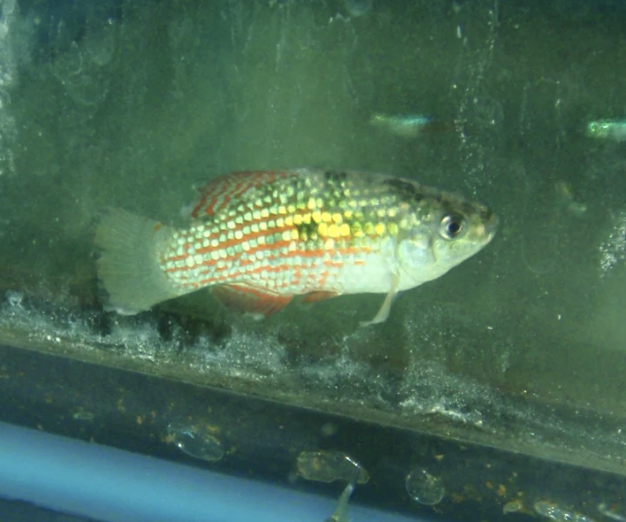 Image 1 of 2
Image 1 of 2

 Image 2 of 2
Image 2 of 2



Misc- Fire Eel (12-14in)
Mastacembelus erythrotaenia, commonly known as the Fire Eel or Zigzag Eel, is a fascinating and unique species that requires specific care to thrive in captivity. Here are the key care requirements:
Tank Requirements
Size: A large tank is essential due to their potential size (up to 39 inches or 100 cm). A minimum tank size of 150 gallons (568 liters) is recommended for an adult.
Tank Dimensions: A tank that is at least 6 feet (1.8 meters) long is ideal to provide ample swimming space.
Substrate: Use a soft sand substrate to prevent injury to their delicate undersides and allow for burrowing.
Filtration: Efficient filtration is crucial due to their large size and messy eating habits. A canister filter or a powerful internal filter with regular maintenance is recommended.
Water Parameters:
Temperature: 75-82°F (24-28°C)
pH: 6.5-7.5
Hardness: Soft to moderately hard water
Water Changes: Perform regular water changes of 20-30% weekly to maintain water quality and keep nitrate levels low.
Feeding
Diet: Fire Eels are carnivorous and require a diet consisting mainly of:
Meaty foods such as live or frozen bloodworms, blackworms, earthworms, shrimp, and small fish.
Offer a varied diet to ensure proper nutrition.
Frequency: Feed them once or twice daily, offering an amount they can consume within a few minutes.
Compatibility
Tank Mates: Fire Eels are generally peaceful but may eat very small fish that can fit into their mouth. Suitable tank mates include larger, peaceful fish that won't compete for food.
Behavior: They are nocturnal and prefer to hide during the day. Provide plenty of hiding places with driftwood, rocks, and caves.
Health and Maintenance
Observation: Regularly monitor their health and behavior for signs of stress, injury, or disease. Fire Eels are susceptible to skin infections if water quality is poor.
Water Quality: Maintain excellent water quality with regular testing and appropriate filtration. Fire Eels are sensitive to ammonia and nitrite levels.
Handling: Minimize handling to reduce stress. If necessary, use a soft net and handle with care to avoid injuring their delicate skin.
Special Considerations
Tank Setup: Provide a well-planted aquarium with plenty of hiding spots and open swimming areas. Ensure the tank has a tight-fitting lid as Fire Eels are known to jump.
Growth Potential: Be prepared for their potential size and plan for their long-term care in a suitably large tank.
Tankmates: Avoid keeping Fire Eels with aggressive or nippy fish, as they are relatively peaceful and can be easily stressed by boisterous tankmates.
By providing a spacious environment with suitable hiding places and a varied diet, you can ensure the health and well-being of your Mastacembelus erythrotaenia in captivity.
Mastacembelus erythrotaenia, commonly known as the Fire Eel or Zigzag Eel, is a fascinating and unique species that requires specific care to thrive in captivity. Here are the key care requirements:
Tank Requirements
Size: A large tank is essential due to their potential size (up to 39 inches or 100 cm). A minimum tank size of 150 gallons (568 liters) is recommended for an adult.
Tank Dimensions: A tank that is at least 6 feet (1.8 meters) long is ideal to provide ample swimming space.
Substrate: Use a soft sand substrate to prevent injury to their delicate undersides and allow for burrowing.
Filtration: Efficient filtration is crucial due to their large size and messy eating habits. A canister filter or a powerful internal filter with regular maintenance is recommended.
Water Parameters:
Temperature: 75-82°F (24-28°C)
pH: 6.5-7.5
Hardness: Soft to moderately hard water
Water Changes: Perform regular water changes of 20-30% weekly to maintain water quality and keep nitrate levels low.
Feeding
Diet: Fire Eels are carnivorous and require a diet consisting mainly of:
Meaty foods such as live or frozen bloodworms, blackworms, earthworms, shrimp, and small fish.
Offer a varied diet to ensure proper nutrition.
Frequency: Feed them once or twice daily, offering an amount they can consume within a few minutes.
Compatibility
Tank Mates: Fire Eels are generally peaceful but may eat very small fish that can fit into their mouth. Suitable tank mates include larger, peaceful fish that won't compete for food.
Behavior: They are nocturnal and prefer to hide during the day. Provide plenty of hiding places with driftwood, rocks, and caves.
Health and Maintenance
Observation: Regularly monitor their health and behavior for signs of stress, injury, or disease. Fire Eels are susceptible to skin infections if water quality is poor.
Water Quality: Maintain excellent water quality with regular testing and appropriate filtration. Fire Eels are sensitive to ammonia and nitrite levels.
Handling: Minimize handling to reduce stress. If necessary, use a soft net and handle with care to avoid injuring their delicate skin.
Special Considerations
Tank Setup: Provide a well-planted aquarium with plenty of hiding spots and open swimming areas. Ensure the tank has a tight-fitting lid as Fire Eels are known to jump.
Growth Potential: Be prepared for their potential size and plan for their long-term care in a suitably large tank.
Tankmates: Avoid keeping Fire Eels with aggressive or nippy fish, as they are relatively peaceful and can be easily stressed by boisterous tankmates.
By providing a spacious environment with suitable hiding places and a varied diet, you can ensure the health and well-being of your Mastacembelus erythrotaenia in captivity.






